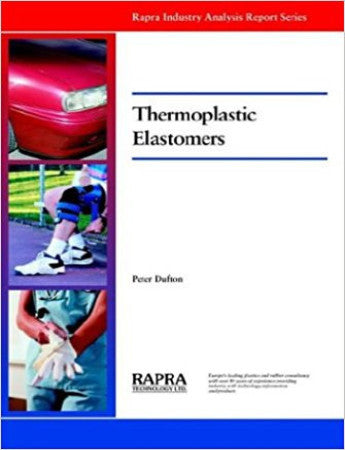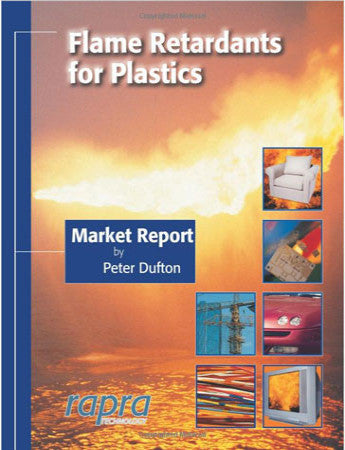Thermoplastic Elastomers
Materials that combine elastomeric properties with many of the attributes of thermoplastics have been available to industry for over twenty years. A wide acceptance of these materials has taken place due to a growing catalogue of experience backed by convincing case studies in many sectors of industrial activity; new-generation materials have been developed to meet the demands of ever more discriminating customers.
This report contains discussion of the different families of thermoplastic elastomer (TPE) materials, and of the trends in material developments. The key end-use sectors are analysed in terms of material usage and future trends. Each sector is examined in some detail starting with reference to activity in Western Europe, the involvement of polymers within the sector, and how important a share of that involvement is held by TPEs. The issues which affect the choice of different materials and how these are likely to impinge on the use of TPEs in future are discussed.
Data on TPE supply and consumption by material family and trends for future consumption are given. Growth in TPE usage is due to three main factors: replacement for other materials, new processing technologies and new applications and markets. TPEs have proven themselves in meeting a wide range of demanding engineering requirements and automotive applications. These applications will continue to grow because of the cost savings provided and the performance delivered.
This report contains discussion of the different families of thermoplastic elastomer (TPE) materials, and of the trends in material developments. The key end-use sectors are analysed in terms of material usage and future trends. Each sector is examined in some detail starting with reference to activity in Western Europe, the involvement of polymers within the sector, and how important a share of that involvement is held by TPEs. The issues which affect the choice of different materials and how these are likely to impinge on the use of TPEs in future are discussed.
Data on TPE supply and consumption by material family and trends for future consumption are given. Growth in TPE usage is due to three main factors: replacement for other materials, new processing technologies and new applications and markets. TPEs have proven themselves in meeting a wide range of demanding engineering requirements and automotive applications. These applications will continue to grow because of the cost savings provided and the performance delivered.
1 Introduction
1.1 Background
1.2 The Report
1.3 Methodology
2 Executive Summary
2.1 Overall
2.2 Materials
2.3 General
3 TPE Technologies
3.1 Introduction
3.2 Styrenic Block Copolymers (SBCs)
3.3 Thermoplastic Olefins (TPOs)
3.4 Thermoplastic Vulcanisates (TPVs)
3.5 Thermoplastic Polyurethane Elastomers (TPUs)
3.6 Copolyesters (COPEs)
3.7 Copolyamides (COPAs)
4 Material Developments, Products and Trends
4.1 Styrenic Block Copolymers (SBCs)
4.2 Thermoplastic Olefins (TPOs)
4.3 Thermoplastic Vulcanisates (TPVs)
4.4 Thermoplastic Polyurethane Elastomers (TPUs)
4.5 Copolyesters (COPEs)
4.6 Copolyamides (COPAs)
4.7 Other TPE Materials
5 End-User Markets for Thermoplastic Elastomers
5.1 Automotive
5.2 General Mechanical and Industrial Rubber Products
5.3 Footwear
5.4 Medical and Healthcare Markets
5.5 Other Market Sectors
6 The Supply and Demand for Thermoplastic Elastomers
6.1 Summary
6.2 Current Supply and Demand by Material
6.3 Notes on Suppliers and Compounders
6.4 Estimated Future Demand for TPEs
7 Processing, Machinery and Other Factors
7.1 Extrusion
7.2 Injection Moulding
7.3 Finishing and Assembly
7.4 Machinery
7.5 Testing Procedures
7.6 Recycling
1.1 Background
1.2 The Report
1.3 Methodology
2 Executive Summary
2.1 Overall
2.2 Materials
2.3 General
3 TPE Technologies
3.1 Introduction
3.2 Styrenic Block Copolymers (SBCs)
3.3 Thermoplastic Olefins (TPOs)
3.4 Thermoplastic Vulcanisates (TPVs)
3.5 Thermoplastic Polyurethane Elastomers (TPUs)
3.6 Copolyesters (COPEs)
3.7 Copolyamides (COPAs)
4 Material Developments, Products and Trends
4.1 Styrenic Block Copolymers (SBCs)
4.2 Thermoplastic Olefins (TPOs)
4.3 Thermoplastic Vulcanisates (TPVs)
4.4 Thermoplastic Polyurethane Elastomers (TPUs)
4.5 Copolyesters (COPEs)
4.6 Copolyamides (COPAs)
4.7 Other TPE Materials
5 End-User Markets for Thermoplastic Elastomers
5.1 Automotive
5.2 General Mechanical and Industrial Rubber Products
5.3 Footwear
5.4 Medical and Healthcare Markets
5.5 Other Market Sectors
6 The Supply and Demand for Thermoplastic Elastomers
6.1 Summary
6.2 Current Supply and Demand by Material
6.3 Notes on Suppliers and Compounders
6.4 Estimated Future Demand for TPEs
7 Processing, Machinery and Other Factors
7.1 Extrusion
7.2 Injection Moulding
7.3 Finishing and Assembly
7.4 Machinery
7.5 Testing Procedures
7.6 Recycling
Peter W. Dufton graduated from Cambridge University in Materials Science before taking a research degree for work on mechanical properties of high strength aircraft materials. He joined Dunlop in 1970 to work on tyre reinforcement materials before moving within the company to technical support and product development in the Overseas Division. This was followed by a period as Overseas Business Development Manager in Dunlop Adhesives.
From 1987-2000 he worked for Rapra as a consultant in the business analysis and publishing areas, undertaking multi-client work in the field of market research on a range of topics. These include tyres, fire-related matters, wire and cable and various other end-use sectors for the polymers, individual polymer materials development and compounding additives. He is also the author of several reports in the Rapra Industry Analysis Series.
From 1987-2000 he worked for Rapra as a consultant in the business analysis and publishing areas, undertaking multi-client work in the field of market research on a range of topics. These include tyres, fire-related matters, wire and cable and various other end-use sectors for the polymers, individual polymer materials development and compounding additives. He is also the author of several reports in the Rapra Industry Analysis Series.
Related Products
Biodegradable Polymers
$390.00
{"id":11242213828,"title":"Biodegradable Polymers","handle":"978-1-85957-519-2","description":"\u003ch5\u003eDescription\u003c\/h5\u003e\nAuthor: David K. Platt \u003cbr\u003eISBN 978-1-85957-519-2 \u003cbr\u003e\u003cbr\u003eRapra Market Report\u003cbr\u003e\n\u003ch5\u003eSummary\u003c\/h5\u003e\nBiodegradable polymers have experienced strong growth over the last three years and are set to make further inroads into markets traditionally dominated by conventional thermoplastics in future. \u003cbr\u003e\u003cbr\u003eDemand is being driven by a number of factors. \u003cbr\u003eThe cost of biodegradable polymers has come down considerably over the last three years while at the same time standard thermoplastic prices have increased considerably. Now, some classes of biodegradable polymers are price competitive with polymers such as PET. \u003cbr\u003e\u003cbr\u003eThe biodegradable polymers industry itself has established an agreed framework for testing and certification and there is growing political pressure in developed countries to reduce packaging waste and develop a composting infrastructure. Biodegradable polymer producers have also invested in product and process improvements. Finally, consumers and brand owners are beginning to recognize the benefits of sustainable or ‘green’ packaging. \u003cbr\u003e\u003cbr\u003eFour main classes of biodegradable polymers are analyzed in this report, polylactic acid (PLA), starch-based polymers, synthetic biodegradable polymers, such as aromatic aliphatic co-polyesters, and polyhydroxyalkanoates (PHA). The report analyses their key performance properties, applications development, market drivers and future prospects. Each product section also contains an estimate of market size by world region and end use market, plus forecasts to 2010. There is also an analysis of key suppliers and their products. \u003cbr\u003e\u003cbr\u003e\u003cb\u003eKey Features\u003c\/b\u003e \u003cbr\u003eBiodegradable polymers market size by geographic region, polymer type and end use sector, 2000 and 2005, plus forecasts to 2010. Market opportunity analysis by end use sector, such as packaging, bags and sacks, foodservice, agriculture, medical, consumer products and fibres. Illustrations of product and applications development over the last three years. Supply chain analysis: including details of thirty leading biodegradable polymer suppliers and profiles of around fifty of the world’s leading biodegradable polymer processors. Analysis of biodegradable polymer performance properties, market drivers, applications and product developments.\u003cbr\u003e\u003cbr\u003e\n\u003ch5\u003eAbout Author\u003c\/h5\u003e\nDavid Platt graduated from the University of Nottingham with an Economics degree before completing an MBA at the University of Bradford. He joined a leading international market consultancy where he specialized in plastics sector research. He conducted a wide range of multi-client and single-client studies covering a wide range of materials, from standard thermoplastics, engineering and high performance polymers to conductive polymers and thermoplastic elastomers. Now operating as a freelance consultant, he makes regular contributions to the European plastics trade press, and works with leading plastics industry consultants.","published_at":"2017-06-22T21:13:20-04:00","created_at":"2017-06-22T21:13:20-04:00","vendor":"Chemtec Publishing","type":"Book","tags":["2006","agriculture","analysis","aromatic aliphatic co-polyesters","bags","biodegradable polymers","book","consumer products","foodservice","market","medical","packaging","PHA","PLA","polyhydroxyalkanoates","polylactic acid","polymer","polymers","properties","report","sacks","starch-based polymers","synthetic biodegradable polymers"],"price":39000,"price_min":39000,"price_max":39000,"available":true,"price_varies":false,"compare_at_price":null,"compare_at_price_min":0,"compare_at_price_max":0,"compare_at_price_varies":false,"variants":[{"id":43378350852,"title":"Default Title","option1":"Default Title","option2":null,"option3":null,"sku":"","requires_shipping":true,"taxable":true,"featured_image":null,"available":true,"name":"Biodegradable Polymers","public_title":null,"options":["Default Title"],"price":39000,"weight":1000,"compare_at_price":null,"inventory_quantity":1,"inventory_management":null,"inventory_policy":"continue","barcode":"978-1-85957-519-2","requires_selling_plan":false,"selling_plan_allocations":[]}],"images":["\/\/chemtec.org\/cdn\/shop\/products\/978-1-85957-519-2.jpg?v=1498191157"],"featured_image":"\/\/chemtec.org\/cdn\/shop\/products\/978-1-85957-519-2.jpg?v=1498191157","options":["Title"],"media":[{"alt":null,"id":350156882013,"position":1,"preview_image":{"aspect_ratio":0.767,"height":450,"width":345,"src":"\/\/chemtec.org\/cdn\/shop\/products\/978-1-85957-519-2.jpg?v=1498191157"},"aspect_ratio":0.767,"height":450,"media_type":"image","src":"\/\/chemtec.org\/cdn\/shop\/products\/978-1-85957-519-2.jpg?v=1498191157","width":345}],"requires_selling_plan":false,"selling_plan_groups":[],"content":"\u003ch5\u003eDescription\u003c\/h5\u003e\nAuthor: David K. Platt \u003cbr\u003eISBN 978-1-85957-519-2 \u003cbr\u003e\u003cbr\u003eRapra Market Report\u003cbr\u003e\n\u003ch5\u003eSummary\u003c\/h5\u003e\nBiodegradable polymers have experienced strong growth over the last three years and are set to make further inroads into markets traditionally dominated by conventional thermoplastics in future. \u003cbr\u003e\u003cbr\u003eDemand is being driven by a number of factors. \u003cbr\u003eThe cost of biodegradable polymers has come down considerably over the last three years while at the same time standard thermoplastic prices have increased considerably. Now, some classes of biodegradable polymers are price competitive with polymers such as PET. \u003cbr\u003e\u003cbr\u003eThe biodegradable polymers industry itself has established an agreed framework for testing and certification and there is growing political pressure in developed countries to reduce packaging waste and develop a composting infrastructure. Biodegradable polymer producers have also invested in product and process improvements. Finally, consumers and brand owners are beginning to recognize the benefits of sustainable or ‘green’ packaging. \u003cbr\u003e\u003cbr\u003eFour main classes of biodegradable polymers are analyzed in this report, polylactic acid (PLA), starch-based polymers, synthetic biodegradable polymers, such as aromatic aliphatic co-polyesters, and polyhydroxyalkanoates (PHA). The report analyses their key performance properties, applications development, market drivers and future prospects. Each product section also contains an estimate of market size by world region and end use market, plus forecasts to 2010. There is also an analysis of key suppliers and their products. \u003cbr\u003e\u003cbr\u003e\u003cb\u003eKey Features\u003c\/b\u003e \u003cbr\u003eBiodegradable polymers market size by geographic region, polymer type and end use sector, 2000 and 2005, plus forecasts to 2010. Market opportunity analysis by end use sector, such as packaging, bags and sacks, foodservice, agriculture, medical, consumer products and fibres. Illustrations of product and applications development over the last three years. Supply chain analysis: including details of thirty leading biodegradable polymer suppliers and profiles of around fifty of the world’s leading biodegradable polymer processors. Analysis of biodegradable polymer performance properties, market drivers, applications and product developments.\u003cbr\u003e\u003cbr\u003e\n\u003ch5\u003eAbout Author\u003c\/h5\u003e\nDavid Platt graduated from the University of Nottingham with an Economics degree before completing an MBA at the University of Bradford. He joined a leading international market consultancy where he specialized in plastics sector research. He conducted a wide range of multi-client and single-client studies covering a wide range of materials, from standard thermoplastics, engineering and high performance polymers to conductive polymers and thermoplastic elastomers. Now operating as a freelance consultant, he makes regular contributions to the European plastics trade press, and works with leading plastics industry consultants."}
Flame Retardants for P...
$520.00
{"id":11242215876,"title":"Flame Retardants for Plastics","handle":"978-1-85957-385-3","description":"\u003ch5\u003eDescription\u003c\/h5\u003e\nAuthor: Dr. P.W. Dufton \u003cbr\u003eISBN 978-1-85957-385-3 \u003cbr\u003e\u003cbr\u003epages 148\n\u003ch5\u003eSummary\u003c\/h5\u003e\nPlastics materials are used in large volumes in major applications such as buildings, vehicles and electronic appliances. In each of these areas, fire safety is critical. Hence flame retardants have been developed to improve the properties of plastics under the different conditions of processing and use. Flame retardants can act in a variety of ways: by raising the ignition temperature, reducing the rate of burning, reducing flame spread and reducing smoke generation. There are various test methods in use to quantify the effectiveness of different flame retardants and these are described here. \u003cbr\u003e\u003cbr\u003eThis report examines the new developments from a range of flame retardant producers, both in products and product ranges. Besides brominated materials, mineral fillers such as alumina trihydrate hold a large market share, alongside phosphorus compounds, antimony trioxide, borates and intumescent materials. The latter function by forming an insulating char on the surface of the material. Nanocomposites are being tested as flame retardant materials - these and other new types of additive are described \u003cbr\u003e\u003cbr\u003eEnvironmental legislation has affected this sector of the additive industry, particularly in the field of halogenated flame retardants. Brominated flame retardants are widely used, effective materials in many resin formulations. Many pressure groups would like to see compounds containing halogens banned. There are concerns about the potential for release and bioaccumulation of toxic combustion products. However, the evidence shows that where the use of these materials has been reduced, for example in television sets in Europe, the number of fires and consequently deaths has increased. The issues are discussed in this report. \u003cbr\u003e\u003cbr\u003eAt the same time, fire safety requirements for materials have increased. The uncertainty of the situation has lead to major suppliers of flame retardants branching out to secure their position in the market place. Thus larger companies have been purchasing suppliers of alternative types of retardants so that if legislation reduces their share of one sector of the market, they can reap the benefits from their alternative products. \u003cbr\u003e\u003cbr\u003eMarket data on flame retardants is limited, but the available figures from different sources are summarised here. For example, the market size for flame retardants in the USA is currently around half a million tones per year. There is extensive discussion of specific applications, i.e., automotive, building and construction, and electrical and electronic. \u003cbr\u003e\u003cbr\u003eThis technical market report highlights the current work on flame retardants by different companies and for different resins; it describes the situation of flux in the marketplace with the new changes to legislation and gives data on the market size and possible future changes.\u003cbr\u003e\u003cbr\u003e\n\u003ch5\u003eTable of Contents\u003c\/h5\u003e\n1 Introduction\u003cbr\u003e1.1 Background\u003cbr\u003e1.2 The Report\u003cbr\u003e1.3 Methodology \u003cbr\u003e\u003cbr\u003e2. Summary and Conclusions\u003cbr\u003e2.1 Materials\u003cbr\u003e2.2 End User Sectors\u003cbr\u003e2.2.1 Automotive\u003cbr\u003e2.2.2 Electrical Appliances\u003cbr\u003e2.2.3 Business Machines and Consumer Electronics\u003cbr\u003e2.2.4 Building and Construction\u003cbr\u003e2.2.5 Furniture\u003cbr\u003e2.2.6 Trends\u003cbr\u003e2.3 General\u003cbr\u003e2.3.1 Testing and Environmental Factors\u003cbr\u003e2.3.2 Overview \u003cbr\u003e\u003cbr\u003e3. Flame Retardants\u003cbr\u003e3.1 General\u003cbr\u003e3.2 Organic Halogen Compounds\u003cbr\u003e3.3 Phosphorus Compounds\u003cbr\u003e3.4 Antimony Trioxide\u003cbr\u003e3.5 Alumina Trihydrate\u003cbr\u003e3.6 Magnesium Hydroxide\u003cbr\u003e3.7 Zinc Borate\u003cbr\u003e3.8 Intumescent Materials \u003cbr\u003e\u003cbr\u003e4 Products and their Markets\u003cbr\u003e4.1 Organic Halogen Containing Materials\u003cbr\u003e4.1.1 Bromine Compounds\u003cbr\u003e4.1.1.1 Dead Sea Bromine Group\u003cbr\u003e4.1.1.2 Great Lakes\u003cbr\u003e4.1.1.3 Albermarle\u003cbr\u003e4.1.1.4 Ferro Corporation\u003cbr\u003e4.1.1.5 Unitex Chemical Corporation\u003cbr\u003e4.1.2 Chlorine Compounds\u003cbr\u003e4.2 Phosphorus Containing Compounds\u003cbr\u003e4.2.1 Introduction\u003cbr\u003e4.2.2 Polymer Modification\u003cbr\u003e4.2.3 Red Phosphorus\u003cbr\u003e4.2.4 Ammonium Polyphosphate\u003cbr\u003e4.2.5 Phosphorus Oxynitride\u003cbr\u003e4.2.6 Albright \u0026amp; Wilson\u003cbr\u003e4.2.7 Albermarle Corporation\u003cbr\u003e4.2.8 Polymer Tailoring\u003cbr\u003e4.2.9 Akzo Nobel Chemicals\u003cbr\u003e4.2.10 Great Lakes Chemical Corporation\u003cbr\u003e4.2.11 Clariant\u003cbr\u003e4.2.12 Other New Developments\u003cbr\u003e4.3 Inorganic Minerals and Compounds\u003cbr\u003e4.3.1 Antimony Trioxide\u003cbr\u003e4.3.2 Alumina Trihydrate (ATH)\u003cbr\u003e4.3.3 Boron Compounds\u003cbr\u003e4.3.4 Magnesium Hydroxide\u003cbr\u003e4.3.4.1 Technology\u003cbr\u003e4.3.4.2 Commercial Products\u003cbr\u003e4.3.5 Other Inorganic Compounds\u003cbr\u003e4.3.5.1 Iron Compounds\u003cbr\u003e4.3.5.2 Molybdenum Compounds\u003cbr\u003e4.3.5.3 Tin Compounds\u003cbr\u003e4.3.5.4 Talc\u003cbr\u003e4.4 Other Materials\u003cbr\u003e4.4.1 Coatings\u003cbr\u003e4.4.2 Char Forming Polymers\u003cbr\u003e4.4.3 Potassium Compounds\u003cbr\u003e4.4.4 Melamine Compounds\u003cbr\u003e4.4.4.1 Melamine Polyphosphate\u003cbr\u003e4.4.4.2 Melamine Cyanurate (MC)\u003cbr\u003e4.4.5 Silicon Compounds\u003cbr\u003e4.4.6 Graphite\u003cbr\u003e4.4.7 Glass Flake\u003cbr\u003e4.4.8 Low Melting Glasses\u003cbr\u003e4.4.9 Polymer Blends\u003cbr\u003e4.4.10 PTFE\u003cbr\u003e4.4.11 Aluminium Flake\u003cbr\u003e4.4.12 Hindered Amine Light Stabilisers\u003cbr\u003e4.4.13 Nanocomposites\u003cbr\u003e4.4.14 TSWB\u003cbr\u003e4.4.15 Noflan \u003cbr\u003e\u003cbr\u003e5 Polymer Families and Their Flame Retardancy\u003cbr\u003e5.1 Polyolefins\u003cbr\u003e5.1.1 Polyethylene\u003cbr\u003e5.1.2 EVA\u003cbr\u003e5.1.3 Polypropylene\u003cbr\u003e5.2 PVC\u003cbr\u003e5.3 Styrenics\u003cbr\u003e5.4 Polyamides\u003cbr\u003e5.5 Modified PPO (m-PPO)\u003cbr\u003e5.6 Polyurethanes\u003cbr\u003e5.7 Thermosets\u003cbr\u003e5.7.1 Unsaturated Polyesters\u003cbr\u003e5.7.2 Epoxy Resins\u003cbr\u003e5.7.3 Phenolics\u003cbr\u003e5.7.4 PU Casting Systems\u003cbr\u003e5.7.5 Acrylic Resins\u003cbr\u003e5.7.6 Dicyclopentadiene\u003cbr\u003e5.8 Thermoplastic Polyesters\u003cbr\u003e5.9 Polycarbonates\u003cbr\u003e5.10 Other Thermoplastics\u003cbr\u003e\u003cbr\u003e6 Suppliers and the Consumption of FR Additives and Compounds\u003cbr\u003e6.1 General Comments\u003cbr\u003e6.2 Suppliers\u003cbr\u003e6.2.1 Brominated Flame Retardants\u003cbr\u003e6.2.2 Melamine\u003cbr\u003e6.2.3 Phosphorus Flame Retardants\u003cbr\u003e6.2.4 Mineral Filler Flame Retardants\u003cbr\u003e6.2.5 Borate Flame Retardants\u003cbr\u003e6.3 Consumption and Market Data\u003cbr\u003e6.4 Compounding for Flame Retardancy \u003cbr\u003e\u003cbr\u003e7 End-User Market Sectors\u003cbr\u003e7.1 Automotive\u003cbr\u003e7.2 Other Transport\u003cbr\u003e7.3 Electrical Components\u003cbr\u003e7.4 Electronics Products\u003cbr\u003e7.4.1 Telecommunications\u003cbr\u003e7.4.2 Consumer, Brown Goods\u003cbr\u003e7.5 Electrical Cables\u003cbr\u003e7.6 Building and Construction\u003cbr\u003e7.7 Upholstered Furniture and Textiles \u003cbr\u003e\u003cbr\u003e8 Fire Testing\u003cbr\u003e8.1 Introduction\u003cbr\u003e8.2 Specific Tests\u003cbr\u003e8.3 Comparing Test Results\u003cbr\u003e8.4 Tests for Building Materials\u003cbr\u003e8.5 Cable Testing\u003cbr\u003e8.6 Mattress Tests\u003cbr\u003e8.7 Clothing Tests \u003cbr\u003e\u003cbr\u003e9 Environmental and Regulatory Matters\u003cbr\u003e9.1 Fire Safety\u003cbr\u003e9.1.1 European Standards for Television Sets\u003cbr\u003e9.1.2 Brominated Flame Retardants\u003cbr\u003e9.2 Brominated Flame Retardants\u003cbr\u003e9.3 EU Directives\u003cbr\u003e9.4 Recycling Matters\u003cbr\u003e9.5 Postscript\u003cbr\u003eAbbreviations and Acronyms\u003cbr\u003e\u003cbr\u003e\n\u003ch5\u003eAbout Author\u003c\/h5\u003e\nDr. Peter Dufton has extensive experience in writing market reports, having worked with the Rapra Industry Analysis unit for many years.","published_at":"2017-06-22T21:13:27-04:00","created_at":"2017-06-22T21:13:27-04:00","vendor":"Chemtec Publishing","type":"Book","tags":["2003","antimony trioxide","automotive","book","borates","building","construction","electrical appliances","fire safety","fire testing","flame retardants","furniture","intumescent","market size","mineral fillers","nanocomposites","phosphorus compounds","plastic materials","report"],"price":52000,"price_min":52000,"price_max":52000,"available":true,"price_varies":false,"compare_at_price":null,"compare_at_price_min":0,"compare_at_price_max":0,"compare_at_price_varies":false,"variants":[{"id":43378355844,"title":"Default Title","option1":"Default Title","option2":null,"option3":null,"sku":"","requires_shipping":true,"taxable":true,"featured_image":null,"available":true,"name":"Flame Retardants for Plastics","public_title":null,"options":["Default Title"],"price":52000,"weight":1000,"compare_at_price":null,"inventory_quantity":1,"inventory_management":null,"inventory_policy":"continue","barcode":"978-1-85957-385-3","requires_selling_plan":false,"selling_plan_allocations":[]}],"images":["\/\/chemtec.org\/cdn\/shop\/products\/978-1-85957-385-3.jpg?v=1499726435"],"featured_image":"\/\/chemtec.org\/cdn\/shop\/products\/978-1-85957-385-3.jpg?v=1499726435","options":["Title"],"media":[{"alt":null,"id":354807382109,"position":1,"preview_image":{"aspect_ratio":0.767,"height":450,"width":345,"src":"\/\/chemtec.org\/cdn\/shop\/products\/978-1-85957-385-3.jpg?v=1499726435"},"aspect_ratio":0.767,"height":450,"media_type":"image","src":"\/\/chemtec.org\/cdn\/shop\/products\/978-1-85957-385-3.jpg?v=1499726435","width":345}],"requires_selling_plan":false,"selling_plan_groups":[],"content":"\u003ch5\u003eDescription\u003c\/h5\u003e\nAuthor: Dr. P.W. Dufton \u003cbr\u003eISBN 978-1-85957-385-3 \u003cbr\u003e\u003cbr\u003epages 148\n\u003ch5\u003eSummary\u003c\/h5\u003e\nPlastics materials are used in large volumes in major applications such as buildings, vehicles and electronic appliances. In each of these areas, fire safety is critical. Hence flame retardants have been developed to improve the properties of plastics under the different conditions of processing and use. Flame retardants can act in a variety of ways: by raising the ignition temperature, reducing the rate of burning, reducing flame spread and reducing smoke generation. There are various test methods in use to quantify the effectiveness of different flame retardants and these are described here. \u003cbr\u003e\u003cbr\u003eThis report examines the new developments from a range of flame retardant producers, both in products and product ranges. Besides brominated materials, mineral fillers such as alumina trihydrate hold a large market share, alongside phosphorus compounds, antimony trioxide, borates and intumescent materials. The latter function by forming an insulating char on the surface of the material. Nanocomposites are being tested as flame retardant materials - these and other new types of additive are described \u003cbr\u003e\u003cbr\u003eEnvironmental legislation has affected this sector of the additive industry, particularly in the field of halogenated flame retardants. Brominated flame retardants are widely used, effective materials in many resin formulations. Many pressure groups would like to see compounds containing halogens banned. There are concerns about the potential for release and bioaccumulation of toxic combustion products. However, the evidence shows that where the use of these materials has been reduced, for example in television sets in Europe, the number of fires and consequently deaths has increased. The issues are discussed in this report. \u003cbr\u003e\u003cbr\u003eAt the same time, fire safety requirements for materials have increased. The uncertainty of the situation has lead to major suppliers of flame retardants branching out to secure their position in the market place. Thus larger companies have been purchasing suppliers of alternative types of retardants so that if legislation reduces their share of one sector of the market, they can reap the benefits from their alternative products. \u003cbr\u003e\u003cbr\u003eMarket data on flame retardants is limited, but the available figures from different sources are summarised here. For example, the market size for flame retardants in the USA is currently around half a million tones per year. There is extensive discussion of specific applications, i.e., automotive, building and construction, and electrical and electronic. \u003cbr\u003e\u003cbr\u003eThis technical market report highlights the current work on flame retardants by different companies and for different resins; it describes the situation of flux in the marketplace with the new changes to legislation and gives data on the market size and possible future changes.\u003cbr\u003e\u003cbr\u003e\n\u003ch5\u003eTable of Contents\u003c\/h5\u003e\n1 Introduction\u003cbr\u003e1.1 Background\u003cbr\u003e1.2 The Report\u003cbr\u003e1.3 Methodology \u003cbr\u003e\u003cbr\u003e2. Summary and Conclusions\u003cbr\u003e2.1 Materials\u003cbr\u003e2.2 End User Sectors\u003cbr\u003e2.2.1 Automotive\u003cbr\u003e2.2.2 Electrical Appliances\u003cbr\u003e2.2.3 Business Machines and Consumer Electronics\u003cbr\u003e2.2.4 Building and Construction\u003cbr\u003e2.2.5 Furniture\u003cbr\u003e2.2.6 Trends\u003cbr\u003e2.3 General\u003cbr\u003e2.3.1 Testing and Environmental Factors\u003cbr\u003e2.3.2 Overview \u003cbr\u003e\u003cbr\u003e3. Flame Retardants\u003cbr\u003e3.1 General\u003cbr\u003e3.2 Organic Halogen Compounds\u003cbr\u003e3.3 Phosphorus Compounds\u003cbr\u003e3.4 Antimony Trioxide\u003cbr\u003e3.5 Alumina Trihydrate\u003cbr\u003e3.6 Magnesium Hydroxide\u003cbr\u003e3.7 Zinc Borate\u003cbr\u003e3.8 Intumescent Materials \u003cbr\u003e\u003cbr\u003e4 Products and their Markets\u003cbr\u003e4.1 Organic Halogen Containing Materials\u003cbr\u003e4.1.1 Bromine Compounds\u003cbr\u003e4.1.1.1 Dead Sea Bromine Group\u003cbr\u003e4.1.1.2 Great Lakes\u003cbr\u003e4.1.1.3 Albermarle\u003cbr\u003e4.1.1.4 Ferro Corporation\u003cbr\u003e4.1.1.5 Unitex Chemical Corporation\u003cbr\u003e4.1.2 Chlorine Compounds\u003cbr\u003e4.2 Phosphorus Containing Compounds\u003cbr\u003e4.2.1 Introduction\u003cbr\u003e4.2.2 Polymer Modification\u003cbr\u003e4.2.3 Red Phosphorus\u003cbr\u003e4.2.4 Ammonium Polyphosphate\u003cbr\u003e4.2.5 Phosphorus Oxynitride\u003cbr\u003e4.2.6 Albright \u0026amp; Wilson\u003cbr\u003e4.2.7 Albermarle Corporation\u003cbr\u003e4.2.8 Polymer Tailoring\u003cbr\u003e4.2.9 Akzo Nobel Chemicals\u003cbr\u003e4.2.10 Great Lakes Chemical Corporation\u003cbr\u003e4.2.11 Clariant\u003cbr\u003e4.2.12 Other New Developments\u003cbr\u003e4.3 Inorganic Minerals and Compounds\u003cbr\u003e4.3.1 Antimony Trioxide\u003cbr\u003e4.3.2 Alumina Trihydrate (ATH)\u003cbr\u003e4.3.3 Boron Compounds\u003cbr\u003e4.3.4 Magnesium Hydroxide\u003cbr\u003e4.3.4.1 Technology\u003cbr\u003e4.3.4.2 Commercial Products\u003cbr\u003e4.3.5 Other Inorganic Compounds\u003cbr\u003e4.3.5.1 Iron Compounds\u003cbr\u003e4.3.5.2 Molybdenum Compounds\u003cbr\u003e4.3.5.3 Tin Compounds\u003cbr\u003e4.3.5.4 Talc\u003cbr\u003e4.4 Other Materials\u003cbr\u003e4.4.1 Coatings\u003cbr\u003e4.4.2 Char Forming Polymers\u003cbr\u003e4.4.3 Potassium Compounds\u003cbr\u003e4.4.4 Melamine Compounds\u003cbr\u003e4.4.4.1 Melamine Polyphosphate\u003cbr\u003e4.4.4.2 Melamine Cyanurate (MC)\u003cbr\u003e4.4.5 Silicon Compounds\u003cbr\u003e4.4.6 Graphite\u003cbr\u003e4.4.7 Glass Flake\u003cbr\u003e4.4.8 Low Melting Glasses\u003cbr\u003e4.4.9 Polymer Blends\u003cbr\u003e4.4.10 PTFE\u003cbr\u003e4.4.11 Aluminium Flake\u003cbr\u003e4.4.12 Hindered Amine Light Stabilisers\u003cbr\u003e4.4.13 Nanocomposites\u003cbr\u003e4.4.14 TSWB\u003cbr\u003e4.4.15 Noflan \u003cbr\u003e\u003cbr\u003e5 Polymer Families and Their Flame Retardancy\u003cbr\u003e5.1 Polyolefins\u003cbr\u003e5.1.1 Polyethylene\u003cbr\u003e5.1.2 EVA\u003cbr\u003e5.1.3 Polypropylene\u003cbr\u003e5.2 PVC\u003cbr\u003e5.3 Styrenics\u003cbr\u003e5.4 Polyamides\u003cbr\u003e5.5 Modified PPO (m-PPO)\u003cbr\u003e5.6 Polyurethanes\u003cbr\u003e5.7 Thermosets\u003cbr\u003e5.7.1 Unsaturated Polyesters\u003cbr\u003e5.7.2 Epoxy Resins\u003cbr\u003e5.7.3 Phenolics\u003cbr\u003e5.7.4 PU Casting Systems\u003cbr\u003e5.7.5 Acrylic Resins\u003cbr\u003e5.7.6 Dicyclopentadiene\u003cbr\u003e5.8 Thermoplastic Polyesters\u003cbr\u003e5.9 Polycarbonates\u003cbr\u003e5.10 Other Thermoplastics\u003cbr\u003e\u003cbr\u003e6 Suppliers and the Consumption of FR Additives and Compounds\u003cbr\u003e6.1 General Comments\u003cbr\u003e6.2 Suppliers\u003cbr\u003e6.2.1 Brominated Flame Retardants\u003cbr\u003e6.2.2 Melamine\u003cbr\u003e6.2.3 Phosphorus Flame Retardants\u003cbr\u003e6.2.4 Mineral Filler Flame Retardants\u003cbr\u003e6.2.5 Borate Flame Retardants\u003cbr\u003e6.3 Consumption and Market Data\u003cbr\u003e6.4 Compounding for Flame Retardancy \u003cbr\u003e\u003cbr\u003e7 End-User Market Sectors\u003cbr\u003e7.1 Automotive\u003cbr\u003e7.2 Other Transport\u003cbr\u003e7.3 Electrical Components\u003cbr\u003e7.4 Electronics Products\u003cbr\u003e7.4.1 Telecommunications\u003cbr\u003e7.4.2 Consumer, Brown Goods\u003cbr\u003e7.5 Electrical Cables\u003cbr\u003e7.6 Building and Construction\u003cbr\u003e7.7 Upholstered Furniture and Textiles \u003cbr\u003e\u003cbr\u003e8 Fire Testing\u003cbr\u003e8.1 Introduction\u003cbr\u003e8.2 Specific Tests\u003cbr\u003e8.3 Comparing Test Results\u003cbr\u003e8.4 Tests for Building Materials\u003cbr\u003e8.5 Cable Testing\u003cbr\u003e8.6 Mattress Tests\u003cbr\u003e8.7 Clothing Tests \u003cbr\u003e\u003cbr\u003e9 Environmental and Regulatory Matters\u003cbr\u003e9.1 Fire Safety\u003cbr\u003e9.1.1 European Standards for Television Sets\u003cbr\u003e9.1.2 Brominated Flame Retardants\u003cbr\u003e9.2 Brominated Flame Retardants\u003cbr\u003e9.3 EU Directives\u003cbr\u003e9.4 Recycling Matters\u003cbr\u003e9.5 Postscript\u003cbr\u003eAbbreviations and Acronyms\u003cbr\u003e\u003cbr\u003e\n\u003ch5\u003eAbout Author\u003c\/h5\u003e\nDr. Peter Dufton has extensive experience in writing market reports, having worked with the Rapra Industry Analysis unit for many years."}
Functional Additives f...
$180.00
{"id":11242233220,"title":"Functional Additives for the Plastics Industry","handle":"978-1-85957-145-3","description":"\u003ch5\u003eDescription\u003c\/h5\u003e\nAuthor: P.W. Dufton \u003cbr\u003eISBN 978-1-85957-145-3 \u003cbr\u003e\u003cbr\u003e200 pages, softbound\n\u003ch5\u003eSummary\u003c\/h5\u003e\nThis report covers all the major functional additives used in plastics and will be of interest to additive and polymer suppliers, converters, end-users and technical libraries. Included are a technical review of the additives and the new materials available; identification of the factors which could affect their use in future, and coverage of the current situation for their supply and estimates of the demand in Europe for such materials. \u003cbr\u003e\u003cbr\u003e\u003cstrong\u003eAdditives:\u003c\/strong\u003e antimicrobials, antioxidants, antistatic agents, blowing agents, curing agents, compatibilizers, coupling agents, heat stabilizers, lubricants, UV stabilizers, plasticizers, fillers, colorants, flame retardants, modifiers. \u003cbr\u003e\n\u003cp\u003e \u003c\/p\u003e\n\u003cbr\u003e\n\u003ch5\u003eTable of Contents\u003c\/h5\u003e\n\u003cp\u003eIntroduction \u003cbr\u003eSummary and conclusions \u003cbr\u003eTechnology\u003c\/p\u003e\n\u003cli\u003eAntimicrobial agents\u003c\/li\u003e\n\u003cli\u003eAntioxidants\u003c\/li\u003e\n\u003cli\u003eAntistatic agents\u003c\/li\u003e\n\u003cli\u003eBlowing agents\u003c\/li\u003e\n\u003cli\u003eCuring agents\u003c\/li\u003e\n\u003cli\u003eCompatibilisers and coupling agents\u003c\/li\u003e\n\u003cli\u003eHeat stabilisers\u003c\/li\u003e\n\u003cli\u003eLubricants\u003c\/li\u003e\n\u003cli\u003eUV stabilisers\u003c\/li\u003e\n\u003cli\u003ePlasticisers\u003c\/li\u003e\n\u003cli\u003eFillers\u003c\/li\u003e\n\u003cli\u003eColourants\u003c\/li\u003e\n\u003cli\u003eFlame retardants\u003c\/li\u003e\n\u003cli\u003e\n\u003cp\u003eModifiers\u003c\/p\u003e\n\u003cp\u003eProducts and markets(as above) \u003cbr\u003eSupply and demand(as above\u003cstrong\u003e) \u003c\/strong\u003e\u003c\/p\u003e\n\u003cp\u003ePlastics view\u003c\/p\u003e\n\u003c\/li\u003e\n\u003cli\u003ePolyethylene\u003c\/li\u003e\n\u003cli\u003ePolypropylene\u003c\/li\u003e\n\u003cli\u003ePolystyrene and other styrenics\u003c\/li\u003e\n\u003cli\u003ePVC\u003c\/li\u003e\n\u003cli\u003e\n\u003cp\u003eOther polymers\u003c\/p\u003e\n\u003cp\u003eEnvironmental issues – legislation and regulations \u003cbr\u003eAppendix\u003c\/p\u003e\n\u003c\/li\u003e\n\u003cli\u003eList of additive supplier details\u003c\/li\u003e","published_at":"2017-06-22T21:14:22-04:00","created_at":"2017-06-22T21:14:22-04:00","vendor":"Chemtec Publishing","type":"Book","tags":["1998","antimicrobials","antioxidants","antistatic agents","blowing agents","book","colorants","compatibilizers","coupling agents","curing agents","fillers","flame retardants","heat stabilizers","lubricants","modifiers","plasticizers","report","UV stabilizers"],"price":18000,"price_min":18000,"price_max":18000,"available":true,"price_varies":false,"compare_at_price":null,"compare_at_price_min":0,"compare_at_price_max":0,"compare_at_price_varies":false,"variants":[{"id":43378413508,"title":"Default Title","option1":"Default Title","option2":null,"option3":null,"sku":"","requires_shipping":true,"taxable":true,"featured_image":null,"available":true,"name":"Functional Additives for the Plastics Industry","public_title":null,"options":["Default Title"],"price":18000,"weight":1000,"compare_at_price":null,"inventory_quantity":1,"inventory_management":null,"inventory_policy":"continue","barcode":"978-1-85957-145-3","requires_selling_plan":false,"selling_plan_allocations":[]}],"images":[],"featured_image":null,"options":["Title"],"requires_selling_plan":false,"selling_plan_groups":[],"content":"\u003ch5\u003eDescription\u003c\/h5\u003e\nAuthor: P.W. Dufton \u003cbr\u003eISBN 978-1-85957-145-3 \u003cbr\u003e\u003cbr\u003e200 pages, softbound\n\u003ch5\u003eSummary\u003c\/h5\u003e\nThis report covers all the major functional additives used in plastics and will be of interest to additive and polymer suppliers, converters, end-users and technical libraries. Included are a technical review of the additives and the new materials available; identification of the factors which could affect their use in future, and coverage of the current situation for their supply and estimates of the demand in Europe for such materials. \u003cbr\u003e\u003cbr\u003e\u003cstrong\u003eAdditives:\u003c\/strong\u003e antimicrobials, antioxidants, antistatic agents, blowing agents, curing agents, compatibilizers, coupling agents, heat stabilizers, lubricants, UV stabilizers, plasticizers, fillers, colorants, flame retardants, modifiers. \u003cbr\u003e\n\u003cp\u003e \u003c\/p\u003e\n\u003cbr\u003e\n\u003ch5\u003eTable of Contents\u003c\/h5\u003e\n\u003cp\u003eIntroduction \u003cbr\u003eSummary and conclusions \u003cbr\u003eTechnology\u003c\/p\u003e\n\u003cli\u003eAntimicrobial agents\u003c\/li\u003e\n\u003cli\u003eAntioxidants\u003c\/li\u003e\n\u003cli\u003eAntistatic agents\u003c\/li\u003e\n\u003cli\u003eBlowing agents\u003c\/li\u003e\n\u003cli\u003eCuring agents\u003c\/li\u003e\n\u003cli\u003eCompatibilisers and coupling agents\u003c\/li\u003e\n\u003cli\u003eHeat stabilisers\u003c\/li\u003e\n\u003cli\u003eLubricants\u003c\/li\u003e\n\u003cli\u003eUV stabilisers\u003c\/li\u003e\n\u003cli\u003ePlasticisers\u003c\/li\u003e\n\u003cli\u003eFillers\u003c\/li\u003e\n\u003cli\u003eColourants\u003c\/li\u003e\n\u003cli\u003eFlame retardants\u003c\/li\u003e\n\u003cli\u003e\n\u003cp\u003eModifiers\u003c\/p\u003e\n\u003cp\u003eProducts and markets(as above) \u003cbr\u003eSupply and demand(as above\u003cstrong\u003e) \u003c\/strong\u003e\u003c\/p\u003e\n\u003cp\u003ePlastics view\u003c\/p\u003e\n\u003c\/li\u003e\n\u003cli\u003ePolyethylene\u003c\/li\u003e\n\u003cli\u003ePolypropylene\u003c\/li\u003e\n\u003cli\u003ePolystyrene and other styrenics\u003c\/li\u003e\n\u003cli\u003ePVC\u003c\/li\u003e\n\u003cli\u003e\n\u003cp\u003eOther polymers\u003c\/p\u003e\n\u003cp\u003eEnvironmental issues – legislation and regulations \u003cbr\u003eAppendix\u003c\/p\u003e\n\u003c\/li\u003e\n\u003cli\u003eList of additive supplier details\u003c\/li\u003e"}




